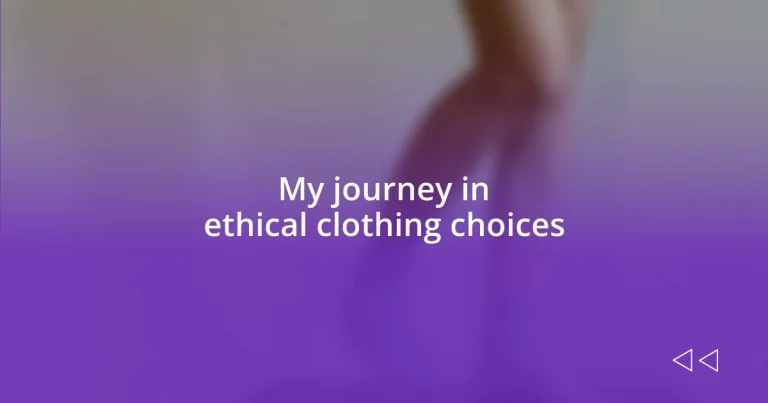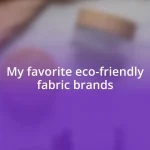Key takeaways:
- Understanding ethical clothing involves reflecting on the impact of purchases on labor rights and environmental sustainability, leading to more informed shopping habits.
- The fast fashion industry contributes significantly to pollution, labor exploitation, and waste, prompting a shift towards sustainable choices that empower consumers.
- Creating a personal ethical guideline helps in making intentional clothing choices that align with individual values regarding sustainability, quality, and ethical manufacturing.
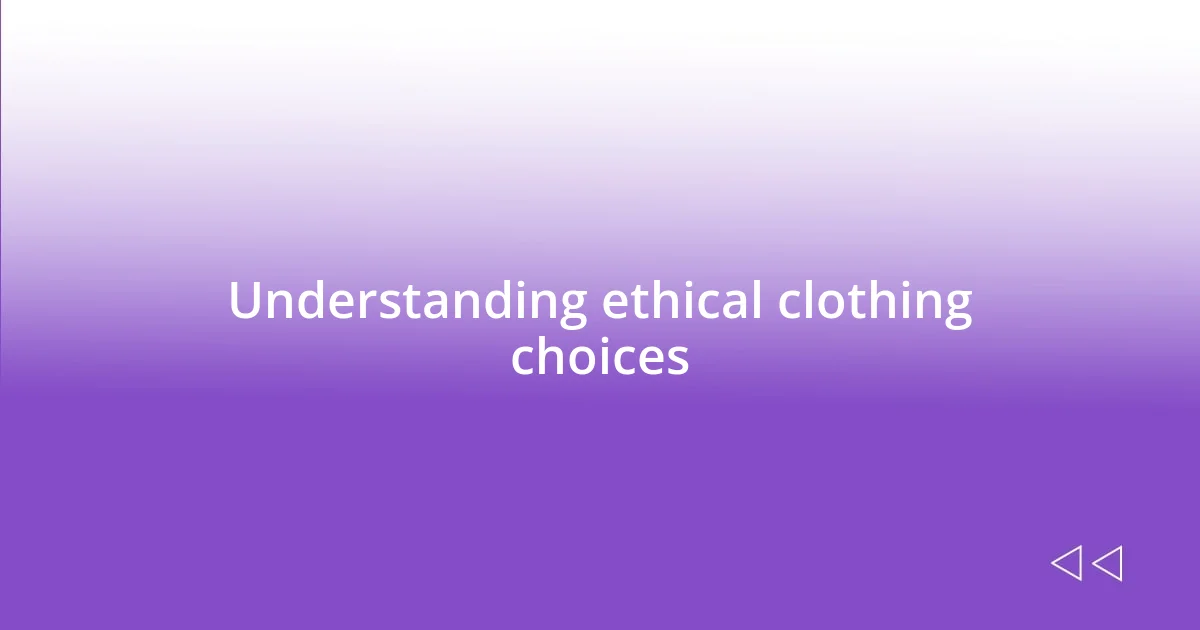
Understanding ethical clothing choices
When I first began exploring ethical clothing choices, I was surprised to discover how interconnected our purchases are with global issues like labor rights and environmental sustainability. I remember standing in my closet, surrounded by fast fashion pieces, and feeling a sinking feeling in my stomach. How could I justify supporting brands that exploit workers and harm the planet?
Understanding ethical clothing goes beyond just looking for fair-trade labels. It invites us to consider the stories behind each garment. I once stumbled upon a small brand that collaborated with artisans in marginalized communities. Learning about their journeys and the impact my purchase would have on their lives made me rethink my shopping habits entirely. How often do we pause to reflect on what our clothes say about our values?
While I’ve made strides toward more mindful choices, it’s an ongoing process. I often ask myself: Is that piece I’m eyeing made with sustainable materials? Do the workers behind it get a fair wage? Every time I make a decision, it feels like a small act of empowerment, bringing me more in line with my beliefs about respect and fairness in fashion.
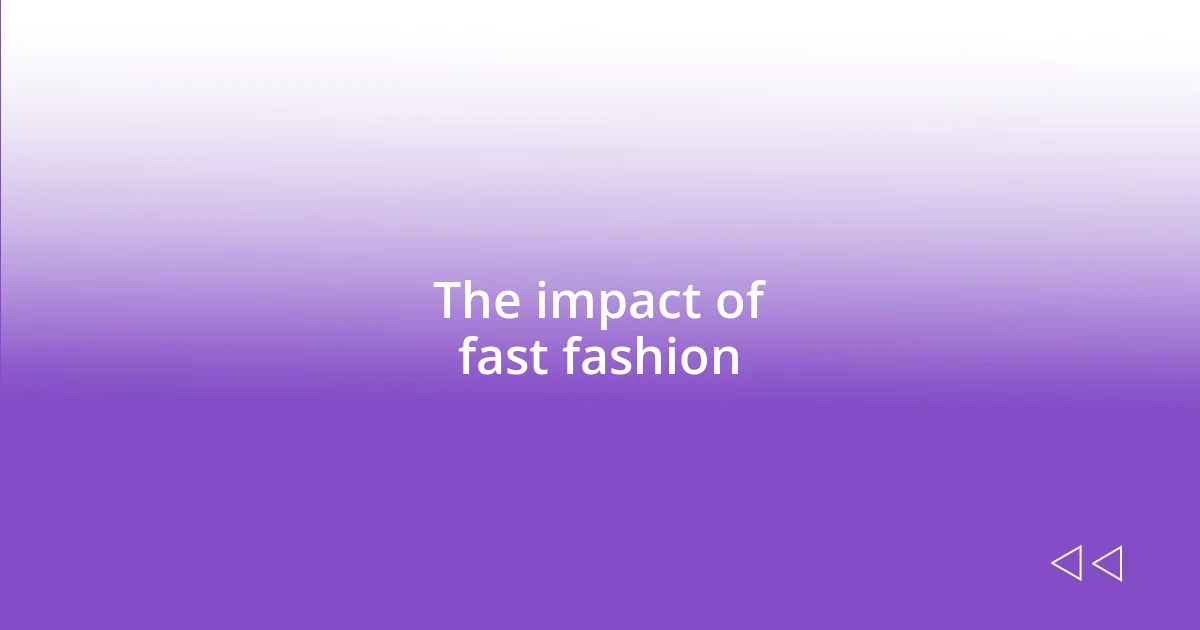
The impact of fast fashion
The impact of fast fashion is profound and often hidden from our view. I remember the excitement I felt when I could snag a trendy outfit for just a few bucks—but that thrill quickly faded when I learned about the environmental repercussions. It’s eye-opening to realize that the sheer volume of clothes produced harms both our planet and vulnerable communities.
Here are some of the stark realities associated with fast fashion:
– Environmental Degradation: The industry is one of the largest contributors to pollution, responsible for a staggering amount of carbon emissions and water waste.
– Labor Exploitation: Many factory workers endure long hours and unsafe conditions, earning a fraction of what they deserve, all for the sake of cheap clothing.
– Landfill Crisis: Around 92 million tons of textiles end up in landfills each year, leading to devastating consequences for our ecosystems.
– Resource Drain: The fast fashion model relies heavily on resource depletion, with vast quantities of water and energy consumed in producing low-cost garments.
– Trendy Cycles: The constant push for new collections encourages over-consumption, fueling a throwaway culture that disregards quality and longevity.
Reflecting on these impacts shifts my perspective entirely. Every time I opt for a more sustainable choice, I feel empowered, knowing I’m part of a larger movement against these devastating trends.
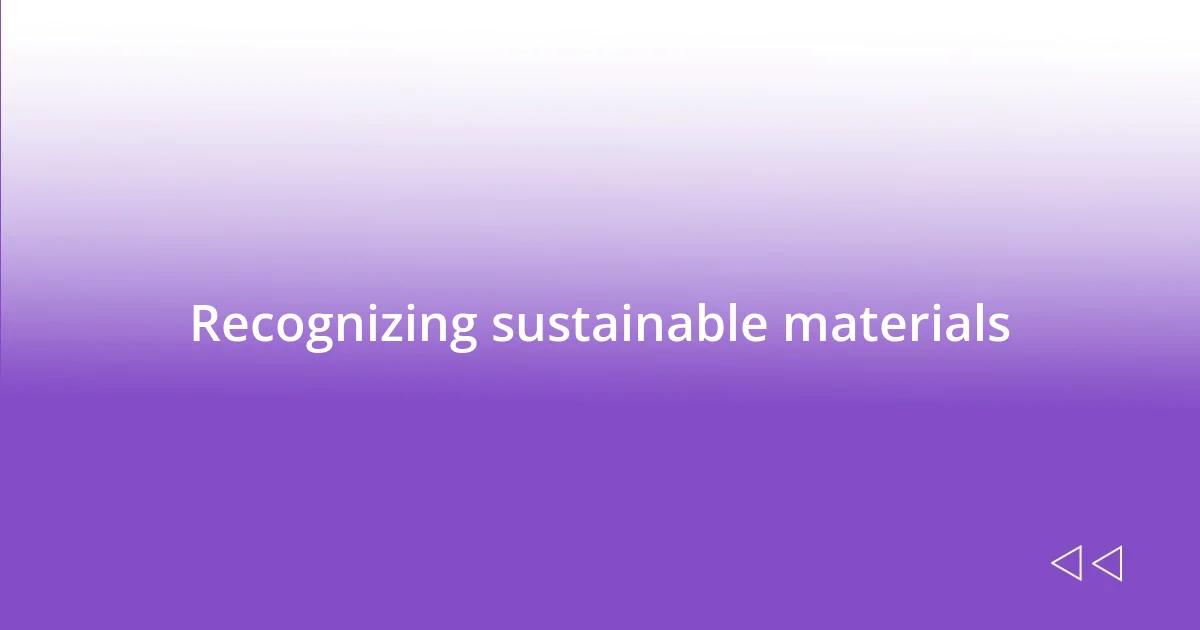
Recognizing sustainable materials
Recognizing sustainable materials is essential for making informed clothing choices. I remember the first time I touched a garment made from organic cotton. It felt different—softer and more breathable—compared to standard cotton. Understanding that organic cotton is produced without harmful pesticides and that it helps reduce environmental impact opened my eyes to the significance of material selection.
As I began to educate myself, I came across other materials like Tencel and hemp. Tencel, made from sustainably sourced wood, is not only biodegradable but also requires less water in its production. Meanwhile, hemp grows quickly and naturally resists pests, making it a more sustainable option compared to conventional fabrics. Each time I discover a new sustainable material, I can’t help but think, “What a small choice that makes such a big difference!”
It’s not always easy to navigate the world of sustainable materials, but learning to recognize them has transformed my shopping habits. I now look for labels that highlight the use of recycled materials or certifications like GOTS (Global Organic Textile Standard). This quest for knowledge and conscious choices brings me joy, as I feel more connected to the impact my clothing has on the world around me.
| Material | Benefits |
|---|---|
| Organic Cotton | Grown without harmful pesticides; softer and breathable. |
| Tencel | Biodegradable and requires less water for production. |
| Hemp | Grows quickly, pest-resistant, and needs minimal resources. |
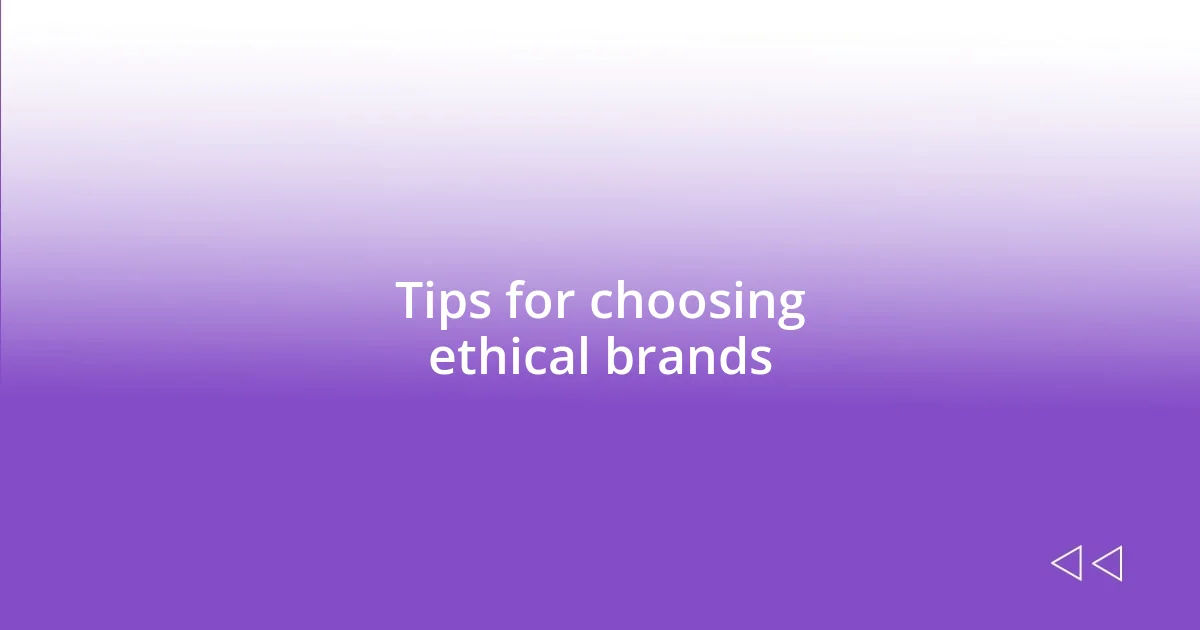
Tips for choosing ethical brands
When seeking out ethical brands, I always start with a little detective work. I remember the first time I visited a brand’s website and discovered their transparency section. It was refreshing to see brands openly discussing their supply chain, labor practices, and environmental initiatives. I often ask myself, “How much do I really know about where my clothes come from?” This inquiry drives me to prioritize companies that are willing to share their story and educate their consumers.
Another tip I’ve found helpful is to look for certifications that speak volumes about a brand’s ethical practices. For example, certification labels like Fair Trade and B Corp are indicators that a company is committed to social and environmental responsibility. The first time I spotted a Fair Trade symbol on a label, I felt a surge of joy knowing that my purchase supported fair wages and safe conditions for workers. When you see such labels, it’s like finding a little badge of honor that confirms your decision is impacting lives positively.
Lastly, my personal rule of thumb now involves avoiding brands that engage in greenwashing. I recall an experience where I was drawn to a label shouting about their eco-friendly practices, only to find no real evidence behind their claims. It left me questioning: “Are they genuinely making an effort or just trying to sell more clothes?” By seeking authenticity and real commitment behind a brand’s marketing, I feel more empowered in my choices and confident that I’m not falling for clever marketing tricks.

Building a capsule wardrobe
Building a capsule wardrobe has been a transformative experience for me, both practically and emotionally. Initially, I felt overwhelmed by the idea of minimizing my clothing collection, but as I dove in, I realized it’s about quality over quantity. When I carefully selected versatile pieces that I truly loved, dressing became much easier—and I found myself more confident in my style. Have you ever noticed how a few well-chosen items can evoke a sense of freedom?
To make my capsule wardrobe meaningful, I focused on timeless styles that could be mixed and matched seamlessly. For example, investing in a classic white shirt and a pair of tailored jeans was a game-changer. I remember wearing that shirt to a casual brunch, then dressing it up later for a meeting by simply adding a statement necklace. It’s this flexibility that excites me about capsule wardrobes; they maximize creativity without overwhelming clutter!
Creating my capsule wardrobe also encouraged me to become more intentional with my purchases. I had to ask myself, “Will this piece serve a purpose in my wardrobe?” It was challenging at first, especially when I found myself eyeing trendy items that had little longevity. But over time, I discovered that choosing pieces that resonate with my values—such as sustainability and durability—brought me a deeper sense of satisfaction. I now cherish those moments when I open my closet and see a cohesive, thoughtful collection that reflects my journey in ethical clothing choices.

Second-hand shopping benefits
One of the most delightful discoveries I made while second-hand shopping is the thrill of finding unique pieces. I remember stumbling across a vintage leather jacket at a local thrift store that instantly transported me back to the rebellious spirit of the ’80s. It wasn’t just about snagging a good deal; it felt like I was unearthing a hidden treasure with a story waiting to be unveiled. Have you ever felt that rush when you find something one-of-a-kind? It’s such a rewarding experience that mainstream shopping simply can’t replicate.
Beyond the excitement of unique finds, second-hand shopping offers incredible savings. The first time I tracked how much I spent versus what I would have spent on new items, I was stunned. I ended up filling my wardrobe with quality pieces for a fraction of the price! This financially savvy approach not only allows me to expand my collection but also leaves me with more in my pocket to invest in other ethical endeavors. Wouldn’t it be great if everyone realized the benefits of this alternative shopping route?
Furthermore, choosing second-hand helps reduce waste and supports a more sustainable fashion ecosystem. I can recall a moment when a friend commented on how much they loved my mismatched, thrifted outfit, and it prompted a conversation about the environmental impact of fast fashion. It felt gratifying to share how my choices not only looked good but also contributed to reducing the demand for new production. Every time I choose pre-loved clothing, I’m reminded that fashion can indeed be both stylish and responsible. Isn’t it fulfilling to know our purchases can make a difference?
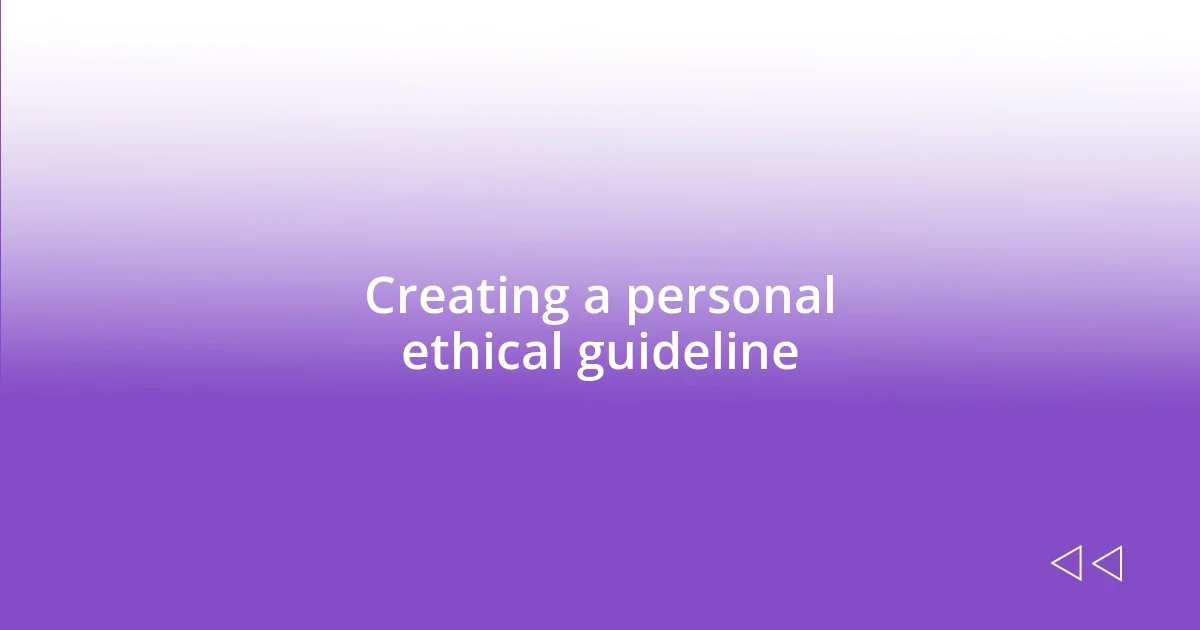
Creating a personal ethical guideline
Creating a personal ethical guideline for my clothing choices wasn’t something I did overnight—rather, it developed as I reflected on my values. One day, while browsing my closet, I realized that some clothes no longer felt like “me.” They were still trendy and new, but didn’t align with my growing commitment to sustainability. I asked myself, “What do I truly stand for when it comes to fashion?” This question led me to prioritize purchases that reflect not just my style but also my ethics.
As I crafted my guidelines, I looked into the stories behind brands and their practices. For instance, I vividly remember reading about a company that uses organic cotton and fair labor. I felt empowered to support businesses that strive for positive change. Moments like these reminded me that each choice I make can foster a shift toward a more ethical fashion industry. It’s like casting a vote with my wallet—have you considered how your spending aligns with your principles?
I also established the “three questions rule”: Does this item serve a purpose? Is it made ethically? Will I cherish it for years to come? This framework helped streamline my decision-making process. I vividly recall holding a beautifully crafted dress in my hands, thinking through these questions before I made the purchase. It wasn’t merely about the fabric; it was about making a connection, and ultimately it felt right to invest in something that honored my values. By sticking to these guidelines, I’m not just expanding my wardrobe—I’m curating an expression of my ethical self.











